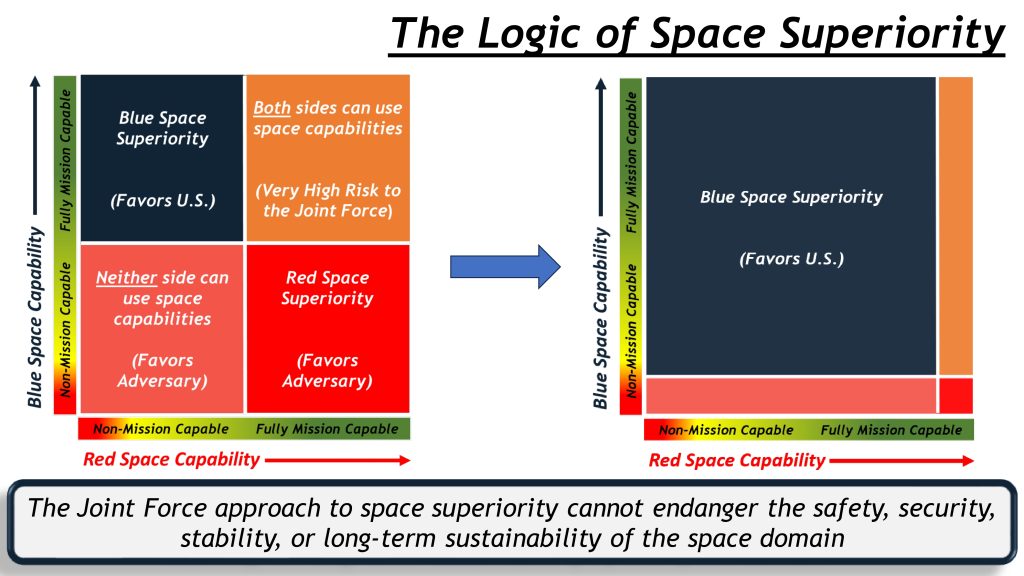The People’s Republic of China’s rapid military advances in space mean the People’s Liberation Army no longer merely threatens American assets in orbit, but now has the space-based sensing and targeting capabilities to better enable its joint forces to threaten the U.S. on Earth, Space Force leaders warned March 27.
Chief of Space Operations Gen. B. Chance Saltzman highlighted the risks in the keynote address at the Mitchell Institute for Aerospace Stutdies’ Spacepower Security Forum in Arlington, Va., where he presented a four-quadrant chart illustrating the competition between U.S. “blue” and Chinese “red” space capability:
- In the top left, U.S. forces dominate, Saltzman said: “This is where we lived for a significant period of time. It’s where we want to be, holding space superiority.”
- In the lower left, neither side is effective in space. In that scenario, Saltzman said China is advantaged, because the U.S. joint force is so reliant on space.
- In the lower right, China achieves space superiority over the U.S., the worst possible outcome for the U.S.
- In the upper right. This signals “a space domain where both blue and red can use space capabilities in the way they want, and I would also argue that this favors the PRC again, because of the localities of the Western Pacific,” Saltzman noted.

“Anything other than the top left is very high risk for the joint force and our ability to project power,” Saltzman warned. And right now, “I think we are in the upper right quadrant.”
Both Russia and China have demonstrated the ability to attack satellites with kinetic and nonkinetic means. But Saltzman and deputy chief of space operations for intelligence Maj. Gen. Gregory J. Gagnon said China has moved beyond simply countering U.S. advantages in space.
“It’s not commonly understood, but since the [People’s Liberation Army Strategic Support Force] in China stood up in December of 2015, they have increased their on-orbit assets by 500 percent,” Gagnon said. “It’s not commonly understood that over the last few years they placed over 200 satellites in orbit each year. And over half of those satellites are for sensing, designed to watch U.S. forces, Japanese forces, Australian forces that are operating in the western Pacific. … So they have profoundly changed not just the threats in space, but the threat from space.”
Saltzman said China’s growing fleet of intelligence, surveillance, and reconnaissance satellites is enabling their “kill webs,” just as the Pentagon is trying to interconnect its sensors and shooters through Joint All-Domain Command and Control (JADC2).
“It has become increasingly apparent over the past decade that the Russians and the PRC are coupling space-based ISR with satellite-aided, precision-guided munitions that can receive SATCOM-updated targeting,” Saltzman said. “Specifically the PRC has more than 470 ISR satellites that are feeding a robust sensor-shooter kill web. … This new sensor shooter kill web creates unacceptable risk to our forward-deployed force. This is something that most of us are just not used to thinking about.”
Kelly D. Hammett, director of the Space Rapid Capabilities Office, noted that while the U.S. private sector has increased the frequency of launches and the number of civilian-owned and operated satellites in orbit, the government is still only in the nascent stage of its long-term program to build a proliferated warfighter architecture. That stands in contrast to the work China has been doing.
“We have a lot of irons in the fire,” Hammett said. “We’re building new capabilities, trying new things, trying to get to assets on range that the operators can test and train against. It’s not the force structure overall that we’re going to need to be able to compete and deter and potentially fight and win against the vast array of assets the Chinese are putting on orbit. There are 400 ISR birds, they’re launching 100 satellites a year, and most of them are very insidious. Well over half of them are space warfighting satellites. They’re not largely commercial.”
Saltzman says the U.S. must counter that threat through “responsible counterspace campaigning,” with weapons and methods that hold Chinese satellites at risk while avoiding destructive acts that would create orbital debris and befoul the domain.
What that means is still not fully clear. Retired Gen. Kevin Chilton, Explorer Chair for the Mitchell Institute’s Spacepower Advantage Center of Excellence, engaged Assistant Secretary of Defense for Space Policy John F. Plumb on the issue of balancing offensive and defensive capabilities in space, and also on how much of that should be brought out into the open. Plumb argued the value of strategic ambiguity, acknowledging some level of capability without offering enough that a rival could “engineer against it.”
A fully functional Space Force is a military branch, and must be capable of exerting military power in its domain, Hammett suggested. That means having the capability to hold Chinese satellites at risk.
“There are a number of evolving threats, and we need to have a full array of … capabilities to address those threats,” Hammett said. “We primarily are the Department of Defense, so we defend and protect, but some of the capabilities we’re working on will have varieties of tactics, techniques, and procedures that [U.S. Space Command] will employ.”
